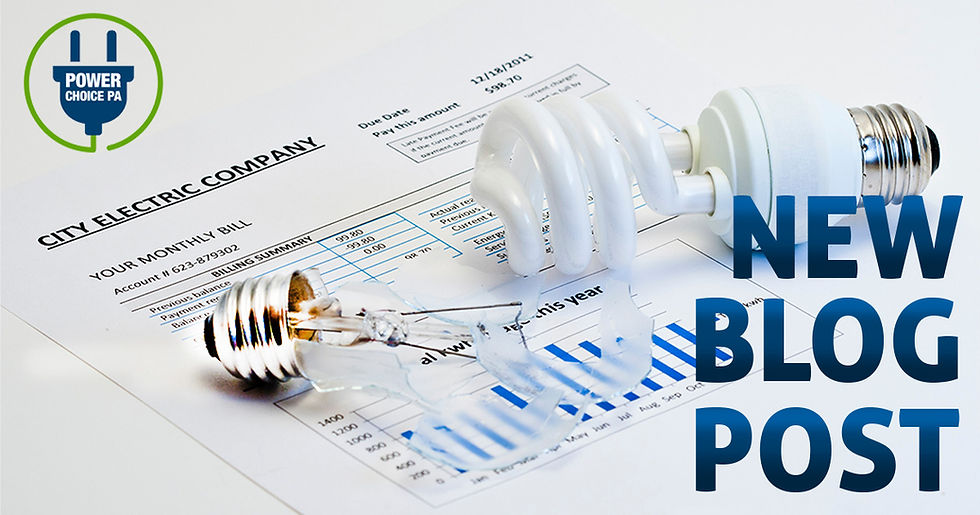Utility Billing Errors Add to Sticker Shock, Continue to Frustrate Customers
- PowerChoice PA

- Feb 2, 2023
- 3 min read

Customers still reeling from electricity rates that skyrocketed this winter were jolted again recently when utility billing errors compounded the lingering sticker shock and left Pennsylvania consumers with monthly bills beyond their budgets.
PPL Electric Utilities reported a “technical system issue” that led to plenty of frustrated and angry electricity customers in January. The issue prevented the Allentown-based utility from accessing actual customer usage data, meaning they had to “estimate” usage.
PPL asked customers to pay the estimated amount for bills due in January and February, a practice permitted by the Pennsylvania Public Utilities Commission, but the estimates left some customers shocked by the amounts.
According to reports, some customers were further annoyed when they couldn’t access their usage data through a self-service option on PPL’s website, with some also saying they spent hours on the phone trying to reach someone at PPL.
In a surprise move, PPL apologized, acknowledging it fell short in both billing practices and responsiveness to customers — and even recommending that customers use the PUC’s online PAPowerSwitch tool to shop for a provider that might offer a lower rate than PPL’s default rate.
The Pennsylvania Office of Consumer Advocate said more than 795,000 customers were affected by the billing snafus.
This isn’t PPL’s first mishap. It’s only the most recent.
In June 2022, the company mailed out thousands of bills incorrectly, even to those who for years have paid online. Customers reported invoices with different customer names and addresses, and with different amounts owed for electricity.
The PUC investigated and found about 12,000 customers got wrong bills, which the company blamed on a data cleanup of mailing addresses.
In August 2021, PPL paid a $5,000 fine after the PUC found the company “improperly billed” residential consumers in 2017 and 2018. The company failed to send out monthly bills to consumers and instead billed them for services in large amounts.
PPL is by no means alone.
In April 2022, Duquesne Light sent a mailing to more than 3,000 of its customers that displayed incorrect customer names and account numbers. Specifically, the envelope was addressed to the appropriate customer, but the letter inside displayed the incorrect customer’s name and account number. Duquesne Light had to pay a $12,500 fine for the offense.
Another major utility company, PECO, terminated service to nearly 50,000 electric customers in 2018 and 2019 without proper notification because of software glitches. The company paid $75,000 in penalties for violating provisions in the Pennsylvania utility code that require it to have direct contact with customers at least three days before a scheduled service shutoff due to nonpayment.
More recently, and in stunning fashion --- during a PUC audit that was released in 2022, the commission found that FirstEnergy charged Pennsylvania customers $2.4 million in “inappropriate costs” related to an ongoing federal criminal investigation in Ohio.
That’s right. Not only were Pennsylvania customers billed incorrectly, but they were wrongly billed for questionable practices in another state!
Legislative changes are afoot to shift the customer billing relationship to where it should be, with the customer’s supplier of service, rather than the utility.
Utilities continue to fight the shift, known as Supplier Consolidated Billing (SCB), arguing that retail electric suppliers shouldn’t handle billing. Given utilities’ track record, change is necessary, as these examples show.
SCB, which allows the retail supplier to consolidate all electricity costs into one bill (including utility costs) and invoice the customer directly, just makes more sense.
Think of it this way: When you order merchandise from an online retailer, you don’t get billed by FedEx or UPS, which deliver the product. You get billed by the online retailer, with shipping charges included. Your electric bill should be no different.
When you order a product --- in this case, electricity --- from a retail supplier, you pay the retail supplier directly while the retail supplier is responsible for paying “shipping” to the utility for its billed costs.
SCB also increases innovation, improves transparency and openness, and encourages conservation, because consumers know exactly who they’re dealing with, how much energy they’re using, and what they’re being charged.
Maybe utilities should focus on their core mission, ensuring the reliability of transmission and distribution, and leave the billing to those who know best.




Comentários